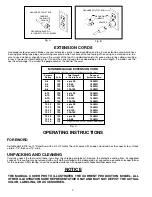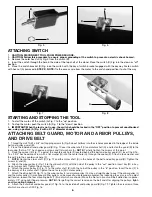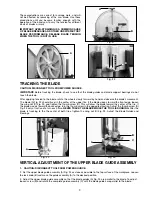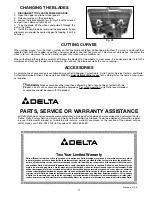
ADJUSTING LOWER BLADE GUIDES
AND BLADE SUPPORT BEARING
Adjust the lower blade guides and blade support bearing after the the
upper guides and bearing have been adjusted.
1.
DISCONNECT TOOL FROM POWER SOURCE.
2. Adjust the front edge of the guide blocks (B) so that they are just
behind the “gullets” of the saw teeth. Turn the knurled knob (C) Fig. 27
to make this adjustment. Check the support bearing. It should not be
touching the back of the blade.
3. Loosen the two screws (A) Fig. 27. Move the guides (B) as close as
possible to the side of the blade, being careful not to pinch the blade.
Tighten screws (A).
4. Turn the other knurled knob (E) to adjust the lower blade support
bearing (D) Fig. 27, so that it is about 1/64" behind the back of the
blade.
BAND SAW BLADES
A bandsaw blade is a delicate piece of steel that is subjected to a great deal of strain. Proper blade care results in optimal
performance. Always use blades of the proper thickness, width, and temper to correspond to the workpiece. Use the widest
blade possible. Narrow blades should be reserved for small, abrupt curves and delicate work.
When pressure is required to push a workpiece through the blade, either file and set the blade, or replace it. A broken blade can
be welded or brazed, but if the blade has been work-hardened, it will soon break again. A good rule of thumb is to sharpen the
blade after 4 hours of operation.
Band saw blades will break because of the peculiar stresses to which they are subjected. However, many blades break because
the operator (1) does not check the alignment and adjust the guides; (2) forces or twists the blade around a short-radius curve;
(3) feeds the workpiece too fast; (4) allows the blade to become dull; (5) tightens the blade tension excessively; (6) sets the
top blade guide too high; (7) uses a blade that has been improperly brazed or welded; and/or (8) runs the blade continuously
when not cutting. Blades for the standard 14" Band Saw are 93-1/2" long. The saw can adjust to a maximum length of 94" and
a minimum of 91-1/2".
OPERATING THE BAND SAW
CAUTION: DISCONNECT TOOL FROM POWER SOURCE.
Before engaging the tool, make all adjustments and put all guards in place. Turn the upper wheel clockwise by hand to be sure
that everything is correct
prior
to connecting tool to power source.
Keep the top guide close to the work. Do not force the material against the blade. Light contact with the blade will permit
easier following of the line and will prevent excess friction, heating, and work-hardening of the blade at its back edge. Keep the
saw blade sharp and very little pressure will be required for average cutting. Avoid twisting the blade by turning abrupt corners.
ADJUSTING UPPER BLADE GUIDES
AND BLADE SUPPORT BEARING
Adjust the upper blade guides and blade support bearings
ONLY
AFTER
the blade has the correct tension and is tracking properly. To
adjust, do the following:
1.
DISCONNECT TOOL FROM POWER SOURCE
2. Make sure that the bottom blade guides and support bearings are
clear of the blade.
3. Adjust the guides (A) Fig. 26, so that the front edge of the guides are
just behind the “gullets” of the saw teeth. The complete guide block
bracket can be moved in or out by loosening the thumb screw (C) and
turning the knurled knob (D) Fig. 26. When the guides (A) are set prop-
erly, tighten thumb screw (C).
5. Two set screws (B) Fig. 26 hold the upper blade guides (A) in place.
Loosen the set screws (B) to move the guides (A). Place them as close
as possible to the side of the blade. (Be careful not to pinch the blade). Tighten the screws (B).
6. The upper blade support bearing (E) Fig. 26 prevents damage to the set in the saw teeth by keeping the blade from being
pushed too far toward the back. The support bearing (E) should be set 1/64" behind the blade by loosening the thumb screw
(F) and turning the knurled knob (G) to move the support bearing (E) in or out.
7. Adjust the blade support bearing (E) so that the back edge of the blade overlaps the outside diameter of the ball bearing by
about 1/16". The bearing (E) is set on an eccentric. To change the position, remove the screw (H) and bearing (E) Fig. 26. Loosen
the thumb screw (F), back out the knurled knob from the set screw. Remove the hex shaft from the hole, and rotate it to move
the eccentric for the bearing.
8. When the blade guide wears to a point that it cannot be adjusted close to the blade, loosen screw (B) Fig. 26 and reverse
the blade guides (A) Fig. 26.
Fig. 27
Fig. 26
10
A
D
E
G
H
B
B
C
F
A
B
A
B
D
C
E






























